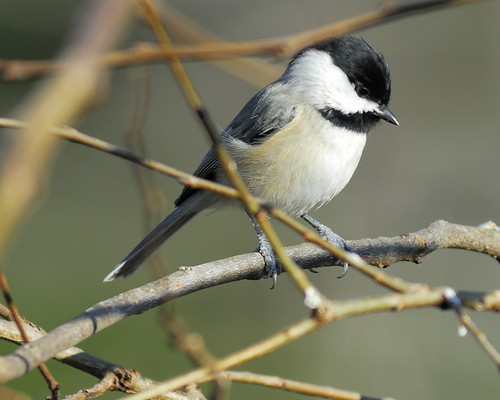tags: Carolina Chickadee, Poecile carolinensis, birds, mystery bird, bird ID quiz
[Mystery bird] Carolina Chickadee, Poecile carolinensis, photographed in the photographer's back yard in Houston, Texas. [I will identify this bird for you in 48 hours]
Image: Joseph Kennedy, 18 January 2010 [larger view].
Nikon D200, Kowa 883 telescope with TSN-PZ camera eyepiece 1/320s f/8.0 at 1000.0mm iso400.
Please name at least one field mark that supports your identification.
More like this
This is a summary of several of the better books I’ve had the opportunity to review here, organized in general categories.
tags: birds, mystery bird, bird ID quiz
tags: conservation, endangered species,
Family Guy, S07E02 'I Dream of Jesus':
Peter: Brian, can I see that paper for a sec?
(Brian gives Peter the paper. Peter peruses the paper.)
Peter: Huh... that's odd... I thought that would big news.


The range maps push one very strongly in one particular direction, and I can't really see enough to make any useful distinctions based on plumage, so I think I'm just going to listen to one of my favorite James Taylor songs and call it a day.
Poecile atricapillus.
http://images.google.ca/images?hl=fr&num=100&oe=UTF8&q=Poecile%20atrica…
Seems straightforward but since it is a "mystery" bird-is it just the light or does it look like some white at the tip of the tail?
Because of the angle, you can't really discern much from the secondaries and greater coverts (the black-capped would be more white than the Carolina). This bird doesn't have much color on its flanks which suggests Carolina, but the nevadensis subspecies of the black-capped will also have paler flanks. Based on the range, the "neater" bib, and the fact that the nape looks more pale grey than white to me, I'm going with Carolina chickadee.
Although I can't see this photo at work, I'm going to stay away from this one until much later as I study both DC Metro area chickadee species (atricapillus and carolinensis) side by side every week, but range pretty much excludes all but one... further, I think there could only be one subspecies at that, the "agile" one...
John, ca 1973 in the sunshine and moonshine?
An additional point (mentioned in several guides) is that in Carolina's the white cheek fades towards gray as you approach the nape. In Black-capped it stays white.
Unfortunately, a single photo can easily be misleading on this point.
To tell the truth, with what little we know regarding hybrids and weird vocal behaviors, I'm not sure how you could accept a wildly out-of-range chickadee without measurements.
It's a subspecies of chickadee, obviously. Chickadeus extracuteus
Good call, Greg.
Actually, it looks like it was released on his first album, in 1969. But otherwise, yeah, it sounds like we're talking about the same song.
Back home and doing an MBM on both species which are feeding right outside my window as I type- it initially took me a couple of weeks to key in on the reliable differentiating marks but seeing them both together allowed me to compare and contrast and especialy as I tend to see them in the Fall with worn plumage, many of the "key" points in guides assume a fresh plumage and are therefore not always helpful... the photo we have and the species it must be that is currently alternating with it's sister species, a White Nuthatch, and a few Tufted Titmice on a hanging sunflower seed feeder, has four very clear marks for me:
the nape is definitely gray, the cheek transitions from white to light gray and thence into the mid-gray of the nape, the black bib has a distinct bottom line at the breast, and the back shows no sign of green...
the buffiness to the sides assumed for atricapillus is not a reliable differentiator right now as they both show a cinnamon cast to the flanks and contrasting whitish breast in almost identical proportions to each other, but the greenish tinge to the back, the bulkiness and size, and the clean white edges to the secondaries are consistently good for the Black-capped and easily seen this evening...
our photo doesn't show the wings clearly enough but the example outside my window clearly shows secondary edges a lot grayer but even more obvious, and this is the first mark I check on and the most obvious feature for me during the Winter, there is a complete lack of white along the greater wing coverts (in the Black-capped this mark is currently as obvious as the white edges to the secondaries)... an additional mark I also note is that the bib stops short of the nape a lot earlier in carolinensis whereas the bib on atricapillus merges into the nape more often than not...
Thanks, David, for confirming something I remembered from my earliest birding days. I started out on Fort Meade, more than a few years ago now. And I remember that the first winter I was trying to distinguish these two species -- looking back on it at that point, I was probably fooling myself that I could, but it's nice to hear someone discussing having them both there.
Paul,
The following is a nice discussion on the differences between Black-capped and Carolina by David Sibley- many of the characteristics he notes are as I noted above
Sibley, D. 1994. The Identification of Chickadees in New Jersey: A Tool for the Breeding Bird Atlas. Records of New Jersey Birds 20:13-15.